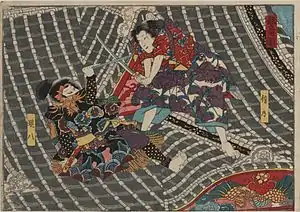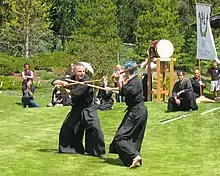Kenjutsu
Kenjutsu (剣術) is an umbrella term for all (ko-budō) schools of Japanese swordsmanship, in particular those that predate the Meiji Restoration. Some modern styles of kendo and iaido that were established in the 20th century also included modern forms of kenjutsu in their curriculum.[1] Kenjutsu, which originated with the samurai class of feudal Japan,[2] means "methods, techniques, and the art of the Japanese sword". This is opposed to kendo, which means "the way of the sword" and uses a bamboo sword (shinai) and protective armour (bōgu).[3]
 Woodblock print by Utagawa Kunisada I (unsigned, the print is the upper part of a "two scenes" print; only the lower part is signed). The actors Seki Sanjūrō III and Bandō Shūka I as Inukai Genpachi and Inuzuka Kiba in the Play Satomi hakkenden, performed at the Ichimura theatre in 1852. | |
| Focus | Weaponry |
|---|---|
| Country of origin | Japan |
| Olympic sport | No |
The exact activities and conventions undertaken when practicing kenjutsu vary from school to school, where the word school here refers to the practice, methods, ethics, and metaphysics of a given tradition, yet commonly include practice of battlefield techniques without an opponent and techniques whereby two practitioners perform kata (featuring full contact strikes to the body in some styles and no body contact strikes permitted in others). Contact striking during kata is used for example in Ono Ha Ittō-ryū. Although kata training has always been the mainstay, in later periods, schools incorporated sparring under a variety of conditions, from using solid wooden bokutō to the use of a bamboo sword (shinai) and armor (bōgu).[3]: XII, XIII In modern times sparring in Japanese martial art is more strongly associated with kendo and is mainly practiced by students or the police force. Although kendo is common in Japan, it is also practiced in other countries around the world.
History
Early development
It is thought likely that the first iron swords were manufactured in Japan in the fourth century, based on technology imported from China via the Korean peninsula.[4]: 1 While swords clearly played an important cultural and religious role in ancient Japan,[4]: 5, 14 in the Heian period the globally recognised curved Japanese sword (the katana) was developed and swords became important weapons and symbolic items.[4]: 15 The oldest schools in existence today arose in the Muromachi period (1336 to 1573), known for long periods of inter-state warfare. Three major schools emerged during this period.[3]: XII
- Kage-ryū (Aizu) (Aisukage ryū)
- Chūjō-ryū
- Tenshin Shōden Katori Shintō-ryū
These schools form the ancestors for many descendent styles, for example, from Ittō ryū has branched Ono-ha Ittō ryū and Mizoguchi-ha Ittō-ryū (among many others).
On the island of Okinawa, the art of Udundi includes a unique method of both Kenjutsu and Iaijutsu. This is the only surviving sword system from Okinawa. It was the martial art of the noble Motobu family during the Ryukyu Kingdom.[5]
Edo period
During the Edo period schools proliferated to number more than 500,[3]: XIII and training techniques and equipment advanced. The 19th century led to the development of the bamboo practice sword, the shinai, and protective armor, bogu. This allowed practice of full speed techniques in sparring, while reducing risk of serious harm to the practitioner.[6] Before this, training in Kenjutsu had consisted mainly of basic technique practice and paired kata, using solid wooden practice swords (bokutō) or live blades.[3]: XIII
Decline
Beginning in 1868, the Meiji Restoration led to the breakup of the military class and the modernization of Japan along the lines of western industrial nations. As the samurai class was officially dissolved at this time, kenjutsu fell into decline, an unpopular reminder of the past.[3]: XIII, XIV This decline continued for approximately 20 years, until rising national confidence led to an increase of the uptake of traditional sword arts again, particularly in the military and the police.
In 1886 the Japanese Police gathered together kata from a variety of kenjutsu schools into a standardised set for training purposes.[7]: 11 This process of standardization of martial training continued when, in 1895, a body for martial arts in Japan, the Dai Nippon Butoku Kai, was established. Work on standardizing kenjutsu kata continued for years, with several groups involved[7]: 11, 12 until in 1912 an edict was released by the Dai Nippon Butoku Kai. This edict highlighted a lack of unity in teaching and introduced a standard core teaching curriculum to which the individual kenjutsu schools would add their distinctive techniques. This core curriculum, and its ten kata evolved into the modern martial art of kendo.[7]: 11, 14 This point could be regarded as the end of the development of Kendo. Kata was provided for the unification of many schools to enable them to pass on the techniques and spirit of the Japanese sword.[8]
20th and 21st century
With the increasing interest in Japanese martial arts outside Japan during the 20th century, people in other countries started taking an interest in kenjutsu.
Weapons
One of the more common training weapons is the wooden sword (bokuto or bokken). For various reasons, many schools make use of very specifically designed bokuto, altering its shape, weight and length according to the style's specifications. For example, bokuto used within Yagyū Shinkage-ryū are relatively thin and without a handguard in order to match the school's characteristic approach to combat. Alternatively, Kashima Shin-ryū practitioners use a thicker than average bokuto with no curvature and with a rather large hilt. This of course lends itself well to Kashima Shin-ryū's distinct principles of combat.
Some schools practice with fukuro shinai (a bamboo sword covered with leather or cloth) under circumstances where the student lacks the ability to safely control a bokuto at full speed or as a general safety precaution. In fact, the fukuro shinai dates as far back as the 15th century.
Nitōjutsu

A distinguishing feature of many kenjutsu syllabi is the use of a paired katana or daitō and wakizashi or shōtō, commonly referred to as nitōjutsu (二刀術, two sword methods). Styles that teach it are called nitōryū (二刀流, two sword school); contrast ittō-ryū (一刀流, one sword school).
The most famous exponent of nitōjutsu was Miyamoto Musashi (1584 – 1645), the founder of Hyōhō Niten Ichi-ryū, who advocates it in The Book of Five Rings. Nitōjutsu is not however unique to Hyoho Niten Ichi-ryū, nor was nitōjutsu the creation of Musashi. Both Tenshin Shōden Katori Shinto-ryū were founded in the early Muromachi period (ca. 1447), and Tatsumi-ryu founded Eishō period (1504–1521), contain extensive two-sword curricula while also preceding the establishment of Musashi's school.[9]
Notable historical Japanese practitioners
- Sasaki Rui 佐々木累
- Nakazawa Koto 中沢琴
- Tatsumi Sankyo 立身三京
- Nen-ami Jion 念阿弥慈恩
- Iizasa Choisai Ienao 飯篠長威斎家直
- Aidu Ikousai Hisatada 愛洲移香斎久忠
- Kamiizumi Nobutsuna 上泉信綱
- Moro-oka Ippa 諸岡一波
- Tsukahara Bokuden 塚原卜伝
- Ashikaga Yoshiteru 足利義輝
- Togo Chui 東郷重位
- Hikita Bungoro Kagetomo 疋田豊五郎景兼
- Marume Kurando-no-Suke Nagayoshi 丸目蔵人佐長恵
- Yagyū Sekishusai Muneyoshi 柳生石舟斎宗厳
- Yagyū Tajima-no-kami Munenori 柳生但馬守宗矩
- Yagyū Jūbei Mitsuyoshi 柳生十兵衛三義
- Harigaya Sekiun 針ヶ谷夕雲
- Itori Koun Tamenobu 井鳥巨雲為信
- Chujo Nagahide 中条長秀
- Toda Gorouzaemon Nyudo Seigen 富田五郎左衛門入道勢源
- Ito Ittosai Kagehisa 伊藤一刀斎景久
- Ono Jiroemon Tadaaki (Mikogami Tenzen) 小野次郎衛門忠明
- Ono Jiroemon Tadatsune 小野次郎衛門忠常
- Mikogami Tenzen 御子神典膳
- Miyamoto Musashi 宮本武蔵玄信
- Aoki Johemon Kaneie (Tetsujin) 青木城衛門金家 (鉄人)
- Sasaki Ganryu佐々木岩流 (In Kodan (old Japanese storytelling), well known as Sasaki Kojiro)
- Chiba Shusaku Narimasa 千葉周作成政
- Momoi Shunzo Naoyoshi 桃井春蔵直由
- Togasaki Teruyoshi 戸ケ崎暉芳
- Iba Hachiro Hidesato 伊庭八郎秀穎
- Negishi Shingoro 根岸信五郎 (Last Edo period headmaster of Shinto Munen-ryu)
- Kubota Suketaro Sugane 窪田助太郎清音
- Ohishi Susumu Tanetsugu 大石進種次
- Otani Seiichiro Nobutomo 男谷精一郎信友
- Yamaoka Tesshu 山岡鉄舟
- Okita Souji沖田総司
- Shingai Tadaatsu真貝 忠篤
- Sakakibara Kenkichi榊原 鍵吉
- Nakayama Hakudo 中山博道
- Kohno Sasaburou 高野佐三郎
- Sasamori Junzo 笹森順造
- Hayashizaki Jinsuke 林崎甚助
Popular culture
- Teenage Mutant Ninja Turtles features kenjutsu being used by Leonardo, Splinter, April O'Neil, Karai, the Shredder, etc. It was also used by Miyamoto Usagi who was an ally for the Turtles and their group as well as the main character of his own series.
- The title character of Samurai Jack included kenjutsu in his fighting style.
- Bruce Wayne learned kenjutsu from Henri Ducard / Ra's al Ghul on Batman Begins. His anime counterpart also used it on Batman Ninja.
- Kenjutsu was an inspiration for sword fighting in Power Rangers Ninja Storm and Power Rangers Samurai.
- Avengers: Endgame and Hawkeye features Hawkeye using kenjutsu.
See also
- Angampora
- Banshay
- Bataireacht
- Bōjutsu
- Gatka
- Jūkendō
- Kalaripayattu
- Kendo
- Kenjutsu
- Krabi–krabong
- Kuttu Varisai
- Mardani khel
- Silambam
- Silambam Asia
- Tahtib
- Thang-ta
- Varma kalai
- World Silambam Association
- Japanese martial arts
- Battōjutsu
- Hokushin Ittō-ryū
- Hyoho Niten Ichi-ryū
- Iaijutsu
- Kashima Shinden Jikishinkage-ryū
- Kashima Shin-ryū
- Kashima Shinto-ryū
- Mizoguchi-ha Ittō-ryū
- Maniwa Nen-ryū
- Muso Jikiden Eishin ryu
- Suiō-ryū
- Samurai
- Shindo Munen-ryu
- Tatsumi-ryū
- Tennen Rishin Ryu
- Tenshin Shōden Katori Shintō-ryū
- Yagyū Shinkage-ryū
Sources
- Classical Warrior Traditions of Japan – 3-volume set by Diane Skoss (Koryu Books):
References
- Budden, Paul (2000). Looking at a Far Mountain: A Study of Kendo Kata. Tuttle Pub. pp. 9, 12, 14. ISBN 978-0-8048-3245-8.
- Martial Arts of the World: An Encyclopedia of History and Innovation, Volume 2, Martial Arts of the World: An Encyclopedia of History and Innovation, Thomas A. Green, Authors Thomas A. Green, Joseph R. Svinth, Editors Thomas A. Green, Joseph R. Svinth, Edition illustrated, Publisher ABC-CLIO, 2010, ISBN 1-59884-243-9, ISBN 978-1-59884-243-2 P.599
- Ozawa, Hiroshi (1997). Kendo The definitive guide. United Kingdom: Kodansha Europe. ISBN 4-7700-2119-4.
- Ozawa, Hiroshi (2008) [2005]. Swords in Ancient Japan. Ideas and History of the Sword (in English and Japanese). Vol. 2. Japan: Kendo Academy Press. p. 1.
- "About Motobu Udundi". 本部流 – Motobu-ryu - (in Japanese). Retrieved 2019-08-21.
- Kindersley, Dorling (2010). Swords. Dorling Kindersley Ltd. p. 286. ISBN 978-1-4053-5136-2.
- Budden, Paul (2000) [2000]. Looking at a Far Mountain. United States of America: Tuttle Publishing. ISBN 0-8048-3245-5.
- "The History of Kendo". All Japan Kendo Federation. Archived from the original on 6 February 2012. Retrieved 19 February 2012.
- Serge Mol, 2003, Classical Weaponry of Japan: Special Weapons and Tactics of the Martial Arts Kodansha International Ltd, ISBN 4-7700-2941-1 (pp.22-23)